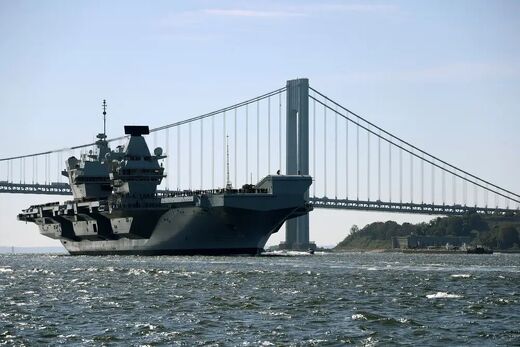
© Royal NavyHMS Queen Elizabeth
HMS
Queen Elizabeth, the Royal Navy's flagship, had to pull out of its role leading the largest NATO exercise since the Cold War at the last minute, the Royal Navy reports.
Routine pre-sailing checks identified an issue with a coupling on the 65,000-ton warship's starboard propeller shaft, preventing it from sailing on Sunday.
The warship was set to participate in an upcoming NATO exercise but
had to be replaced by another UK aircraft carrier, the HMS Prince of Wales.
Despite its standing as the UK Royal Navy's Fleet Flagship, HMS Queen Elizabeth has suffered a series of embarrassing mishaps since it was commissioned in 2017.In 2019, a mechanical issue left the warship "without propulsion" for days before it flooded, Portsmouth paper The News reported.
The ship had to anchor off Britannia Royal Naval College for 24 hours to undergo repairs, per The News.
In 2021, one of the carrier's F-35B fighters crashed in the Mediterranean.The warship, capable of carrying 60 aircraft,
is the largest ever built in the UK costing, £3.1 billion, or $3.9 billion.
HMS
Queen Elizabeth was due to set sail from Portsmouth naval base today and serve as the maritime centerpiece of "Steadfast Defender," the "
largest military exercise in Europe since the Cold War," per NATO's Strategic Warfare Development Command.
HMS
Queen Elizabeth
was to lead a carrier strike group of eight ships in the exercise, including US, Spanish, and Danish vessels, in Norwegian waters and the High North, the UK Defense Journal reports.
The elaborate exercise will feature
20,000 UK military personnel deployed across Scandinavia and Northern Europe, per the Royal Navy.
The British contingent is part
of 90,000 troops from all 31 NATO allies taking part.
HMS Queen Elizabeth's replacement, HMS Prince of Wales, also suffered technical issues with its starboard propeller shaft in 2022, which prompted the additional checks on the flagship.
The forced last-minute cancellation of the HMS
Queen Elizabeth's tour due to a malfunction follows another mishap involving Royal Navy ships.
In January, two UK warships contributing to the Gulf's maritime security collided at a Bahrain port.The HMS
Chiddingfold and HMS
Bangor collided while docking.
Video footage of the latest maritime blunder appeared to show HMS
Chiddingfold reversing into HMS
Bangor.
The UK was once the world's greatest naval power but in 2024 the Royal Navy is a shadow of its former self.
Officials and analysts say the Navy is plagued by a shrunken and aging fleet,
increasing staff shortages, and rising wear and tear as services are put under strain, the
Financial Times reports.
Amid rising staffing issues, the Navy has been lowering entry requirements for recruits to try and bolster its personnel.
Recruits no longer need to have graduated from high school or obtained a GED."There is a
dissonance between the UK's military ambitions and its capabilities," Sir Richard Barrons, former head of Britain's armed forces, said, per the Financial Times. "The risk is that we get drawn into a conflict and can't sustain our presence, and this exposes a strategic weakness."
The House of Commons Defence Committee called the
UK military "consistently overstretched" and under "unrelenting pressure," the Independent reports.
Comment: The number of malfunctions and blunders the US and UK military has suffered in recent years is almost unbelievable, and so either the Navy decided against sending the aircraft carrier and needed an excuse, or it really is a sign of how corrupt and incompetent the UK's military is these days (likely the latter); either way, as is also the case for the US: for such maniacal and aggressive nations to also be so utterly feckless (which historically do go hand in hand) is rather foreboding for its people and their future.
That said, the consequences of same are already evident throughout their respective societies:
- (21th January) $14M engine of US Air Force F-35 destroyed after engineer left flashlight inside it before test run
- (20th January) British warship is out of action after CRASHING into another Royal Navy vessel, ship 'got stuck in reverse'
And 2 weeks ago:- US supersonic bomber crashes
- United, Alaska Airlines find loose hardware on door plugs on several Boeing 737 Max 9 planes
Meanwhile: 'Secret Russian electronic warfare weapon disrupting GPS of ships & jets' claims Estonia's military chief, amid NATO wargames